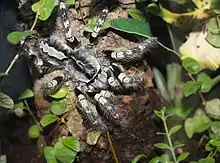| Poecilotheria striata | |
|---|---|
 | |
| Scientific classification | |
| Domain: | Eukaryota |
| Kingdom: | Animalia |
| Phylum: | Arthropoda |
| Subphylum: | Chelicerata |
| Class: | Arachnida |
| Order: | Araneae |
| Infraorder: | Mygalomorphae |
| Family: | Theraphosidae |
| Genus: | Poecilotheria |
| Species: | P. striata |
| Binomial name | |
| Poecilotheria striata Pocock, 1895[3] | |
Poecilotheria striata, or the Mysore ornamental tarantula, is a large arboreal tarantula of the family Theraphosidae. It is endemic to India.
Ecology
The species is found in dry and moist deciduous forests, at altitudes between 500 and 1000 m. It appears to be present in fewer than 10 severely fragmented locations.[1]
Conservation status
P. striata is classified as vulnerable due to its restricted and declining range and occupancy, and the ongoing fragmentation of its habitat. The species is commonly traded in the pet trade.[1] A distribution survey published in 2015 found further population losses and suggested that the species be reclassified as Near Threatened.[4]
References
- 1 2 3 Siliwal, M.; Molur, S.; Daniel, B.A. (2008). "Poecilotheria striata". IUCN Red List of Threatened Species. 2008: e.T63568A12691945. doi:10.2305/IUCN.UK.2008.RLTS.T63568A12691945.en. Retrieved 20 November 2021.
- ↑ "Appendices | CITES". cites.org. Retrieved 2022-01-14.
- ↑ "Taxon details Poecilotheria striata Pocock, 1895". World Spider Catalog. Natural History Museum Bern. Retrieved 29 February 2016.
- ↑ Siliwal, M.; Gupta N.; Molur S. (2013). "The Striated Parachute Spider Poecilotheria striata Pocock, 1895 (Araneae: Theraphosidae): a note on taxonomy, distribution and conservation status". Journal of Threatened Taxa. 5 (12): 4630–4640. doi:10.11609/JoTT.o2956.4630-40.
External links
Wikimedia Commons has media related to Poecilotheria striata.
This article is issued from Wikipedia. The text is licensed under Creative Commons - Attribution - Sharealike. Additional terms may apply for the media files.
